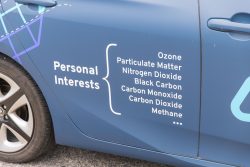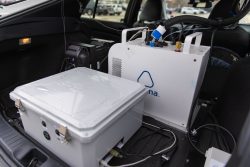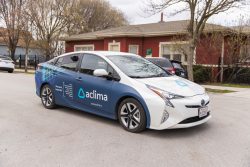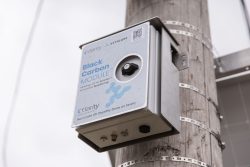ComEd “Drives” Change: New Pilot Studies Air Pollution in Chicago Communities
July 30, 2025
While air quality has worsened here in Chicago and across the nation due to extreme heat and residual wildfire smoke, this has been an ongoing issue for many communities, particularly those in underserved areas, near large highways and industrial corridors. To better understand ways that clean transportation can counteract the environmental and health impacts of pollution, ComEd launched a new air quality monitoring pilot on the City’s South and West Sides.

ComEd began this pilot in late 2024 as part of its Beneficial Electrification (BE) Plan 1, which aims to support customers and communities throughout northern Illinois in the transition to electric vehicles (EVs) and other solutions to curb carbon emissions and its effects on climate change. The pilot’s field work kicked off in early 2025 in three neighborhoods historically impacted by poorer air quality.
“Air pollution has been a complex challenge faced by some of the city’s most sensitive communities,” said Melvin Nicks, a senior program manager for ComEd’s Smart Grid and Innovation team who’s responsible for this pilot. “The air quality pilot is just the beginning of baselining more specific air quality information on a block-by-block level to hopefully benefit these communities in a more targeted way while also learning about the impact of zero emissions technology like electric vehicles.”
The selected neighborhoods—Pilsen, Little Village and the Southeast side of Chicago –were chosen based on key community organizations with environmental focus in these areas including Little Village Environmental Justice Organization, Neighbors for Environmental Justice, Southeast Environmental Taskforce, Pilsen Environmental Rights and Reform Organization and Alliance of the Southeast. ComEd will continue to work with these organizations throughout the duration of the pilot to ensure their communities benefit from the study and are aware of the results.

Air quality monitoring technology inside the vehicle

“By collecting localized data, we’re investing in the health of our community and paving the way for meaningful change. A future with cleaner air starts with understanding what our neighborhoods truly need.” said Olga Bautista, co-executive director of Southeast Environmental Task Force. “Air pollution has been a persistent challenge for neighborhoods like ours, but programs like this pilot offer a crucial opportunity to turn awareness into action.”
The pilot consists of two phases. In Phase One, which kicked off in February, three EV hybrid vehicles outfitted with air quality sensors spent two months driving through these three Chicago neighborhoods. The vehicles collected air quality data at various times of day and at a range of intersections to create a comprehensive snapshot of air quality in these neighborhoods. Phase Two started in early July with the design of a stationary grid-based network of sensors on city light poles at various locations across the communities participating in the pilot.
 One of the pilot’s notable partners, The University of Illinois Chicago’s (UIC) School of Public Health, will be responsible for gathering and analyzing the data collected by the sensors. Spearheading this collaboration is Dr. Serap Erdal, who shared that, “Getting the community lived experience is extremely important to making sure that we’re informed by community observations so that our results not only meet all of the research answers but are also responsive to the community’s needs.”
One of the pilot’s notable partners, The University of Illinois Chicago’s (UIC) School of Public Health, will be responsible for gathering and analyzing the data collected by the sensors. Spearheading this collaboration is Dr. Serap Erdal, who shared that, “Getting the community lived experience is extremely important to making sure that we’re informed by community observations so that our results not only meet all of the research answers but are also responsive to the community’s needs.”
The pilot will run through the end of 2025 with data analyzed and distributed to communities by the beginning of 2026.
Building on its current $231 million BE Plan 1 investment, ComEd will invest an additional $168 million through BE Plan 2 to help residential and non-residential customers transition to and take advantage of electric vehicles. Start contributing to cleaner air for your communities while funding lasts by visiting ComEd.com/EV.
